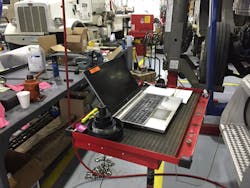Machines may soon get better preventative care than people
Here’s a fun thought for the day: with all the advances being made in remote diagnostics and maintenance algorithms for trucks, cars, bulldozers, and other motorized equipment, it’s becoming increasingly likely that machines are going to be receiving far better “preventative care” than us humans in the very near future.
In fact, according to technology research firm Vanson Bourne (VB), sponsored by the ServiceMax division of GE Digital, some 75% of 450 information technology (IT) and field service leaders it recently polled across the U.S., the U.K., France and Germany believe that machines will receive better “preventative healthcare” than people by 2020.
VB’s new study, After The Fall: Cost, Causes and Consequences of Unplanned Downtime, captured insights from IT professionals scattered across a wide variety of industries – from the manufacturing, medical, telecommunication, and energy sectors to distribution, logistics and transportation, among others.
Unplanned asset downtime is a huge issue across all of those industries, too, VB found, yet one that is not being dealt with effectively:
- Zero unplanned downtime is now the number one priority or a high priority for 72% of organizations polled.
- Yet 70% of companies lack complete awareness of when equipment assets are due for maintenance or upgrade.
- According to research by IT consulting firm Gartner, by 2020, 10% of emergency field service work will be both triggered and scheduled by artificial intelligence.
- 46% of respondents say machines requesting help themselves will help their company better manage their equipment assets.
- 39% of respondents say predictive maintenance would help better manage asset equipment.
Persio Lisboa, executive vice president and COO with Navistar, touched on the importance of minimizing downtime from a trucking perspective in his remarks at the 26th annual Heavy Duty Manufacturers Association breakfast, held at the recent North American Commercial Vehicle (NACV) show.
He for one believes data and analytics will drive advances in trucking industry efficiency productivity while imposing increasingly stringent design requirements for truck and component reliability.
"The transformation to a more productive transportation model is already under way," Lisboa explained. "A fully integrated digital supply chain could remove close to $160 billion of inefficiencies."
Add to that advances in electrified and autonomous vehicle systems, and trucking could be looking at a further $79 billion in efficiency improvements, he stressed.
"When we add together the impact of these three megatrends – electric, autonomous and digital supply chain – the industry has the opportunity, over the next few years alone, to capture a 30% improvement in efficiency, and consequently lower operating costs," Lisboa said.
He also thinks one of the “major drivers” of those trends will be connected vehicles and the information gathered from them – especially as that data will allow for a far more accurate level of prognostics for truck maintenance issues.
For example, he pointed to the impending activation of Navistar’s On Command Connection Live Action Plans in 2018, which is being pilot-tested as we speak. That “connected” feature will provide customers the ability to predict when a part is going to fail before it actually does, using a prognostic model developed using both field service intelligence and algorithms based in big data analytics.
"One day, when the supply chain system is fully integrated, breakdowns and unplanned service events will be remembered only as something in the past," Lisboa emphasized.
Mark Homer, vice president of global customer transformation for ServiceMax, noted in the VB study that this view of data-driven preventive maintenance won’t be just for machines. Eventually, it will get applied to use humans, too, in some way, shape, or form.
“In the same way that organizations want zero unplanned downtime with their equipment assets to avoid expensive loss of production or service, we want to mitigate our own human 'outages,'” he explained.
“This holistic view of how something is operating – whether it’s a person, an equipment plant or an individual component in a machine – has historically been disjointed and only visible when something goes wrong,” Homer said.
“Today, organizations are now acutely aware of the value of a real-time view on the health and performance of their critical assets, as well as predictive analytics on when preventative maintenance or intervention is required, and access to time series data, service history and optimization demands,” he added. “The value of these digital insights in an industrial context is starting to generate interest in preventative maintenance in a human context.”
Now, I am not so sure I want sensors hooked up throughout my body, transmitting a stream of health data regarding so doctors can better plan “maintenance strategies” regarding exercise, diet, etc.
(If said “strategies” include adding more octopus to my diet, for example, a full-scale revolt may ensue; just saying!)
The point of the matter is, with downtime now hugely more problematic for machines and humans alike, we can expect more computer-driven “thinking power” and mathematical algorithms to be deployed in order to keep us both up and running at high performance intervals for longer intervals.


